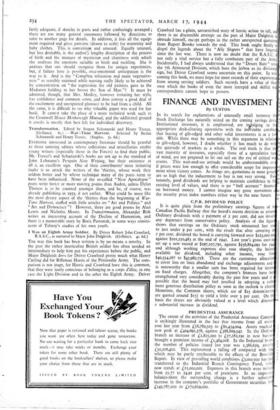FINANCE AND INVESTMENT
By CUSTOS
eI
a
IN its search for explanations of unusually small turnover Stock Exchange has naturally seized on the coming savings dris Institutional investors, it is emphasised, are itkilulging in th appropriate deck-clearing operations with the inelitable corolla that buying of gilt-edged and other solid investments is at a lo ebb. While there may be something in this argument in relati to gilt-edged, however, I doubt whether it has much to do wi the quietude of markets as a whole. The real truth is that th vast majority of investors, especially those of a speculative tun of mind, are not prepared to let out sail on the eve of critical w events. This wait-and-see attitude would be understandable ev if prices were low enough to offer considerable scope for imprrn ment when victory comes. As things are, quotations in most grou are so high that the inducement to buy is not very strong. For tunately, good dividends are helping to maintain confidence in th existing level of values, and there is no "bull account" financ on borrowed money. I cannot imagine any great movement the security price index numbers either way in the near future.
C.P.R. DIVIDEND POLICY
It is quite plain from the preliminary earnings figures of t Canadian Pacific Railway that the board's recent decision to resu Ordinary dividends with a payment of 2 per cent. did not involi any departure from conservative policy. Analysis of the figur shows that earnings on the Ordinary stock amounted last v to just under 9 per cent., with the result that after covering 2 per cent, dividend the board is carrying forward over $225,000, against $201,250,483 at the end of 1942. Last year's gross earn set up a new record at $297,107,791, against $256,864,091 for I and although working expenses also rose sharply, the balan available for dividend, including other income, rose ft $40,354,267 to $42,982,718. There are the customary allocao to cover loss on lines abandoned and exchange adjustments and is noteworthy that a smaller sum has been required for inte on fixed charges. Altogether, the company's finances have strengthened very considerably during the past few years and it possible that the board may feel justified in adopting a rath more generous distribtition policy as soon as the outlook is clear Meantime, the Common shares, which are of $25 denominat are quoted around $i51- to yield a little over 3 per cent. On basis the shares are obviously valued at a level which discoun a substantial increase .in dividend.
PRUDENTIAL ASSURANCE
The extent of the activities of the Prudential Assurance Com is strikingly illustrated in the fact that income from all sour rose last year from £58,780,503 to £61,434,004. Assets reached new peak at £404,691,378, against £388,869,542. In the Ordina branch an increase of £4825,000 to £27,282,191 in new bus:n brought a premium income of £1,484,018. In the Industrial bran the number of policies issued last year was 1,386,629, assur. £51,216,4Io. This represented a falling off compared with which may be partly attributable to the effects of the Bevend Report. In view of prevailing world conditions £3,000.000 has transferred to the Industrial Branch Contingency Fund, la hi now stands at £11,000,000. Expenses in this branch were redu from 25.77 to 24.91 per cent. of premiums. In an • impres, balance-sheet the outstanding change is a further substant increase in the company's portfolio of Government securities f £145,787,000 to £172,629,000.


























 Previous page
Previous page